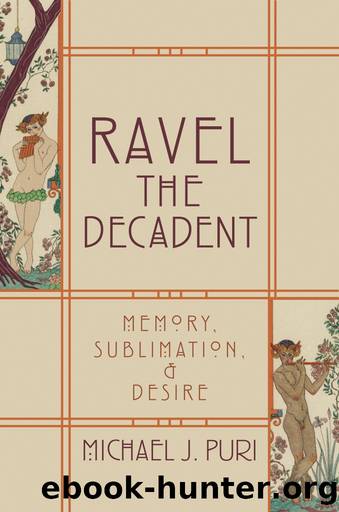Ravel the Decadent by Puri Michael J.;

Author:Puri, Michael J.; [Puri, Michael J.;]
Language: eng
Format: epub
ISBN: 9780199735372
Publisher: OxfordUP
Published: 2011-09-15T00:00:00+00:00
The Dialectic of the Idyll and the Bacchanal
Throughout this chapter I have taken license in referring to the finale of Daphnis as a Bacchanale since it appears in the score only as a âDanse générale,â the generic designation for a ballet number that involves the entire corps. However, when revelers âdressed in Bacchic costumeâ stream across the stage at the beginning of the dance, we are in no doubt as to what we are witnessing. Due to a strong affinity between the finale and the War Dance on the basis of their music, as well as their actionâwhich, in the case of the War Dance, involves an increase in activity until the pirates finally collapse in drunken exhaustionâI have considered the War Dance to be at least bacchanalian, if not an outright bacchanal.
All of which raises the question, what exactly is bacchanalian about the Bacchanale and the War Dance? From these two examples we can extrapolate a number of hallmark characteristics. In general, the music is aggressive, belligerent (in the etymological sense of âwarlikeâ), primitivist, elemental, relentless, frenzied, heterogeneous, borderline chaotic, eruptive, and ecstatic. Specific compositional features include a lively tempo, swift, chromatic melodies, brash and discordant harmonies, sharp and widespread accentuation, quivering textures (trills, tremolos, and drumrolls), driving percussion, a continuous pulse stream in small rhythmic divisions, and long-range intensifications that lead to massive climaxes. In Ravelâs music, however, a bacchanal is just as important for what it is not: an idyll. Ravel does not simply juxtapose the two genres but rather sets them into a dialectic, which means that the one cannot be understood without the other and that the one implies the presence of the other whether or not the other is actually present. Moreover, as the members of a dialectic, the idyll and the bacchanal embody poles of experience, complementary ways of doing and being. Since they are both potentially memory genres, their dialectic is also mnemonic: The idyll is passéist, likes to âruminesceâ at leisure and sublimate desire into a beautiful, static vision, while the bacchanal is oblivious to or at least unsentimental toward the past and finds its participants mobilized by raw, unsublimated desire.
We have already seen how this dialectic informs Daphnis, as reflected in multiple dichotomies: the bipolar behavior of the Dance of Daphnis, with its composed exterior and hemorrhagic interior, the opposition between the Religious Dance of part one and the War Dance of part two, and the hybridized Daybreak and Bacchanale, where the former is an idyll crackling with libidinous energy and the latter a bacchanal with a nostalgic conscience. The dialectic is not confined to Daphnis, however, but is remarkable in Ravelâs entire oeuvre, surfacing most often in finales that either remain content to foreground idyllic moments against a bacchanalian background or work toward a synthesis of the two. One example that immediately comes to mind is the âFinalâ of the Trio (1914). Its primary theme is perfectly idyllic, evoking the nascent dawn with pianissimo harmonics and tremoli in the strings, as well as pentatonicism and open fifths in the piano.
Download
This site does not store any files on its server. We only index and link to content provided by other sites. Please contact the content providers to delete copyright contents if any and email us, we'll remove relevant links or contents immediately.
| Appreciation | Blank Sheet Music |
| Composition | Conducting |
| Exercises | Instruction & Study |
| Lyrics | MIDI, Mixers, etc |
| Philosophy & Social Aspects | Songwriting |
| Techniques | Theory |
| Vocal |
The Goal (Off-Campus #4) by Elle Kennedy(13459)
Kathy Andrews Collection by Kathy Andrews(11706)
Diary of a Player by Brad Paisley(7458)
What Does This Button Do? by Bruce Dickinson(6121)
Assassin’s Fate by Robin Hobb(6101)
Big Little Lies by Liane Moriarty(5677)
Altered Sensations by David Pantalony(5027)
Pale Blue Dot by Carl Sagan(4883)
Sticky Fingers by Joe Hagan(4083)
The Death of the Heart by Elizabeth Bowen(3530)
The Heroin Diaries by Nikki Sixx(3478)
Beneath These Shadows by Meghan March(3248)
Confessions of a Video Vixen by Karrine Steffans(3229)
How Music Works by David Byrne(3155)
The Help by Kathryn Stockett(3066)
Jam by Jam (epub)(3003)
Harry Potter 4 - Harry Potter and The Goblet of Fire by J.K.Rowling(2971)
Strange Fascination: David Bowie: The Definitive Story by David Buckley(2780)
Petty: The Biography by Warren Zanes(2681)
